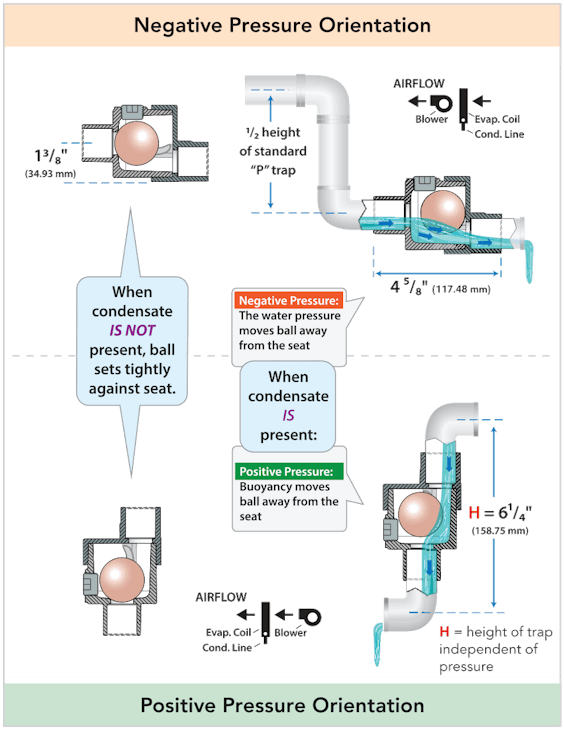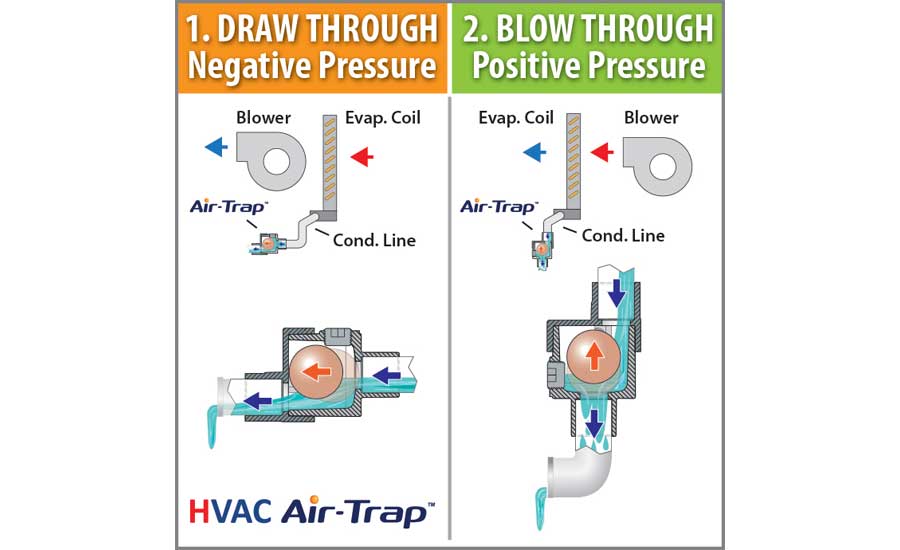A Trap in the Condensate Line Prevents
In most homes there. It also prevents siphoning.

Sioux Chief 3 4 In Slip In T Pvc Drain Trap In 2022 Slip Pvc Sioux
Without a trap this doesnt happen.

. A trap in the condensate line prevents ____. The p-trap helps prevent this. This leave-in product preserves condensate flow while giving peace of mind against costly water damage or flooding.
Properly installed condensate discharge locations facilitate a steam traps ability to remove drain and return condensate vent noncondensable gases and help eliminate water hammer in steam lines while preventing steam loss through the location. A trap in the condensate line prevents _____. Additional cooling load from warm air being drawn up into the air handler C.
Herein what is the purpose of a drain trap. The weight of the water in the trap is enough to prevent this while still allowing condensation to flow freely. What is a condensate drain line.
This vent is AFTER the trap and must remain open to be effective. All of the above. The trap could be plumbed in such a way that a vent is unneeded but depending on the layout it may be easier to connect a vent for that trap to a plumbing vent.
Because the coil is under positive pressure when the system is running air would rush right out of the condensate lines. Shortening the drain pipe to give water less space in which to freeze can also be effective. When the trap is omitted efficiency is lowered as air is lost through the condensate drain in blow-through.
Introducing the Asurity Pro-Treat Line Guard. The trap in the condensate line offsets the negative pressure on the drain that can prevent the water from draining. For example tiny bits of the heat exchanger may be corroded and can end up in the sump and ultimately in the condensate trap.
The best way to stop condensate drain line freeze is to use weather-proof sleeves placed around the drain. Here is our finished product. Another key component of a P-Trap is an air vent The Air vent prevents the drain that comes after the P-Trap from siphoning the water in the trap out.
The primary purpose of a condensate trap is to prevent air from moving in or out of the coil box or air handler during operationTraps must be installed in a manner that will stop the air from passing through but still allow the condensate to drain from the condensate pan. The vent should be beyond the trap 3 or 4 pc The purpose of this is it prevents whats called blow by thats where the units air interferes with the condensate and will prevent it from draining. Additional cooling load from warm air drawn up into the air handler.
Insect invasion of the system D. The primary purpose of a condensate trap is to prevent air from moving in or out of the air handler during operation. The job of a condensate trap is to safely collect and release the condensation produced by the boiler preventing any vapours created during the combustion process from escaping with it.
The important dimensions for a P-Trap are. During periods of snow verify that snow hasnt risen to the level of the drain line where it can block it and cause further freezing. Hi Larry I believe there is a trap and vent added to the condensate drains.
As long as the condensate drain is connected to the homes plumbing a trap is needed to prevent the sewer gas from entering the space. Air and foreign material from being drawn up into the drain line b. Typically HVAC equipment is fitted with P traps that require water or another liquid within a standpipe to prevent gas from entering or leaving the unit.
Traps must be installed in a manner that will stop the air from passing through but still allow the condensate to drain from the condensate pan. Condensate trickles in from the coil side causing an equal amount to trickle out the other side and down to a sewer drain or some other acceptable location. A copper and silver infused line that prevents slime from attaching to the inside of a condensate line and causing build up and blockages.
Air and foreign material from being drawn up into the drain line B. The Air-Trap allows liquid condensate to drain from the HVAC equipment and simultaneously prevents air from entering or escaping from the equipment. The vent opening should always rise above the trip level of the condensate overflow switch when it is in the primary drain line or pan or above the secondaryaux overflow port on the primary drain pan.

Time To Reconsider Use Of P Traps For Condensate Removal Hpac Engineering

Does The Furnace Drain Need A Trap Hvacseer Com

Using The Hvac Air Trap For Condensate Removal In Hvac Systems 2020 03 27 Achr News
No comments for "A Trap in the Condensate Line Prevents"
Post a Comment